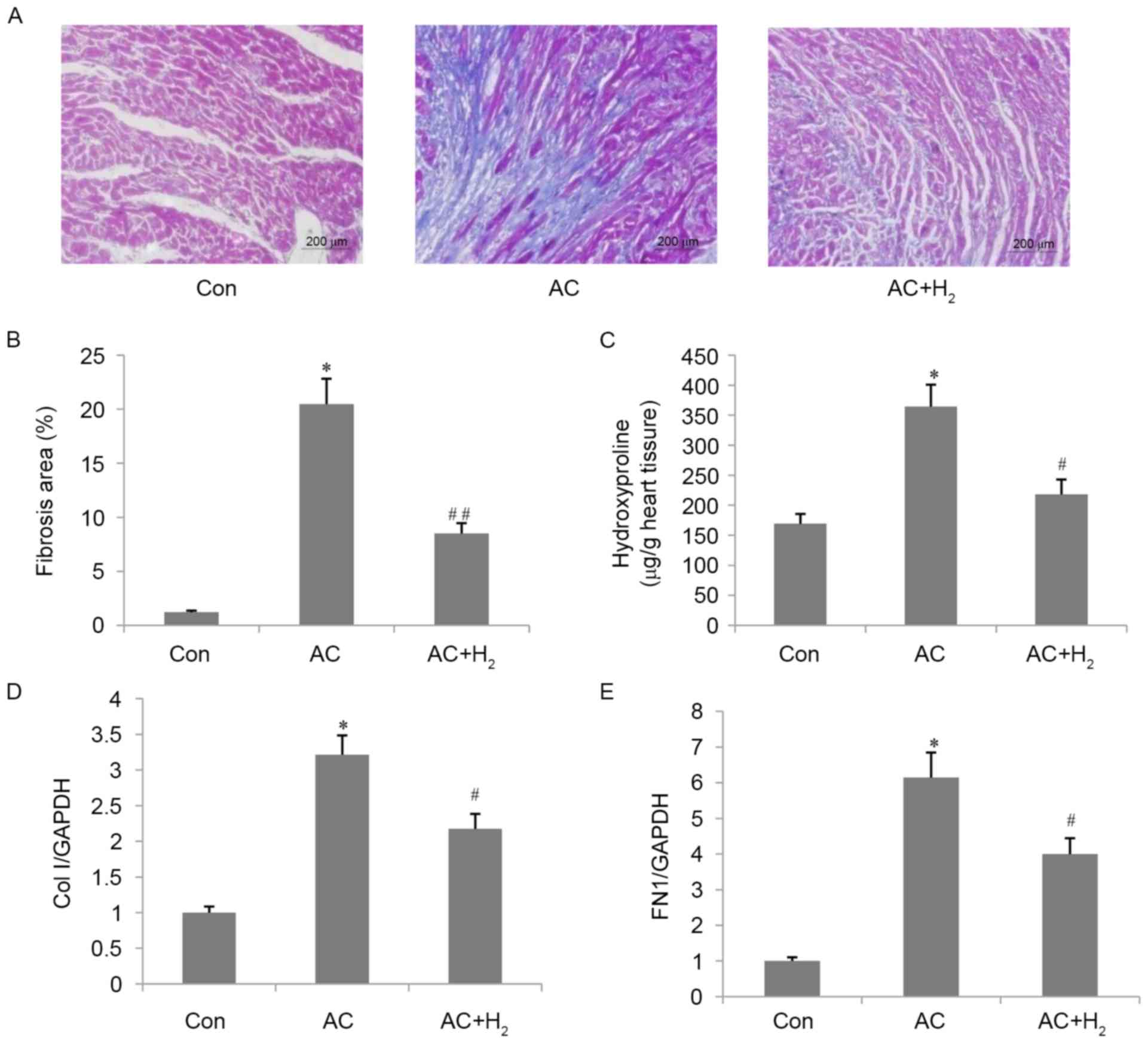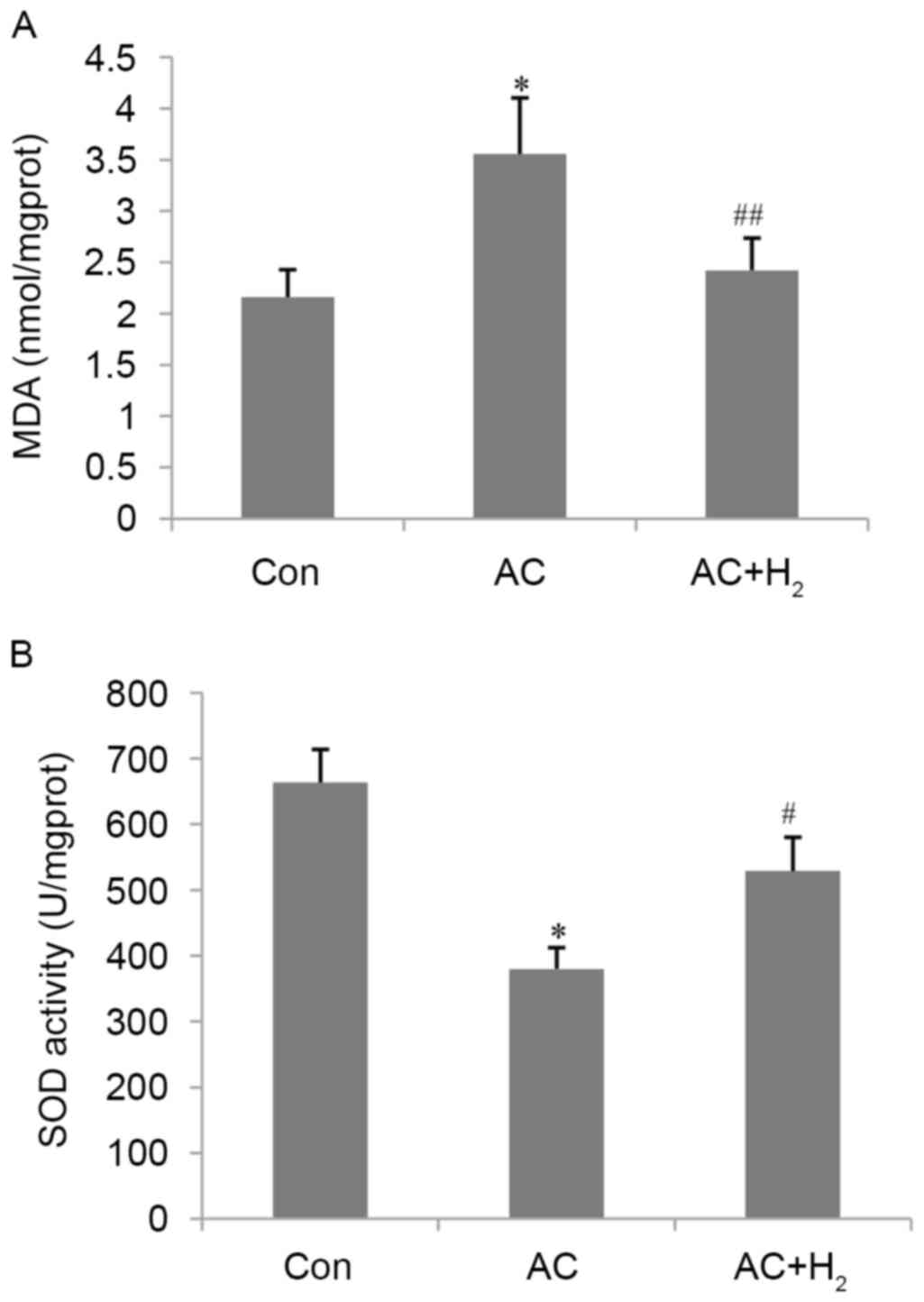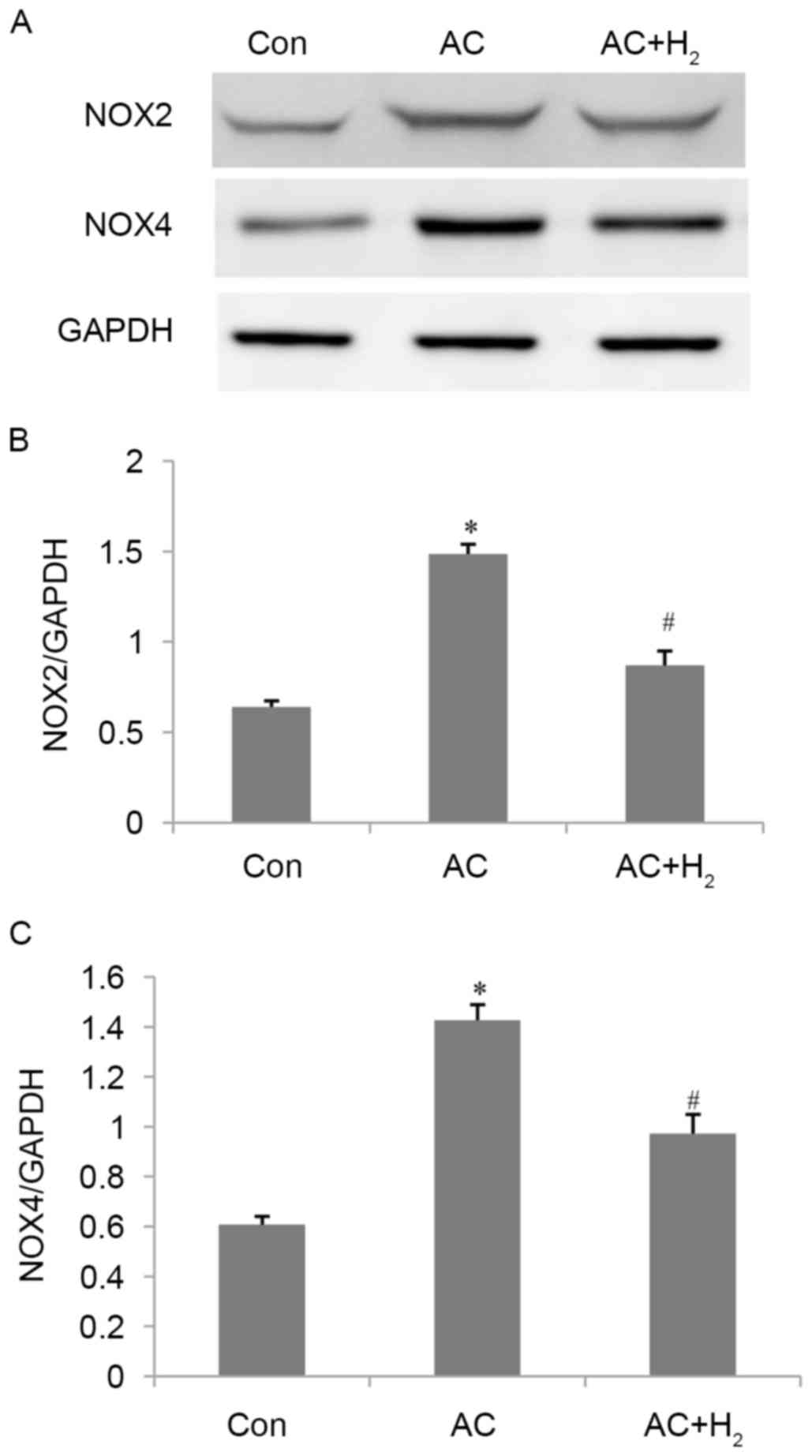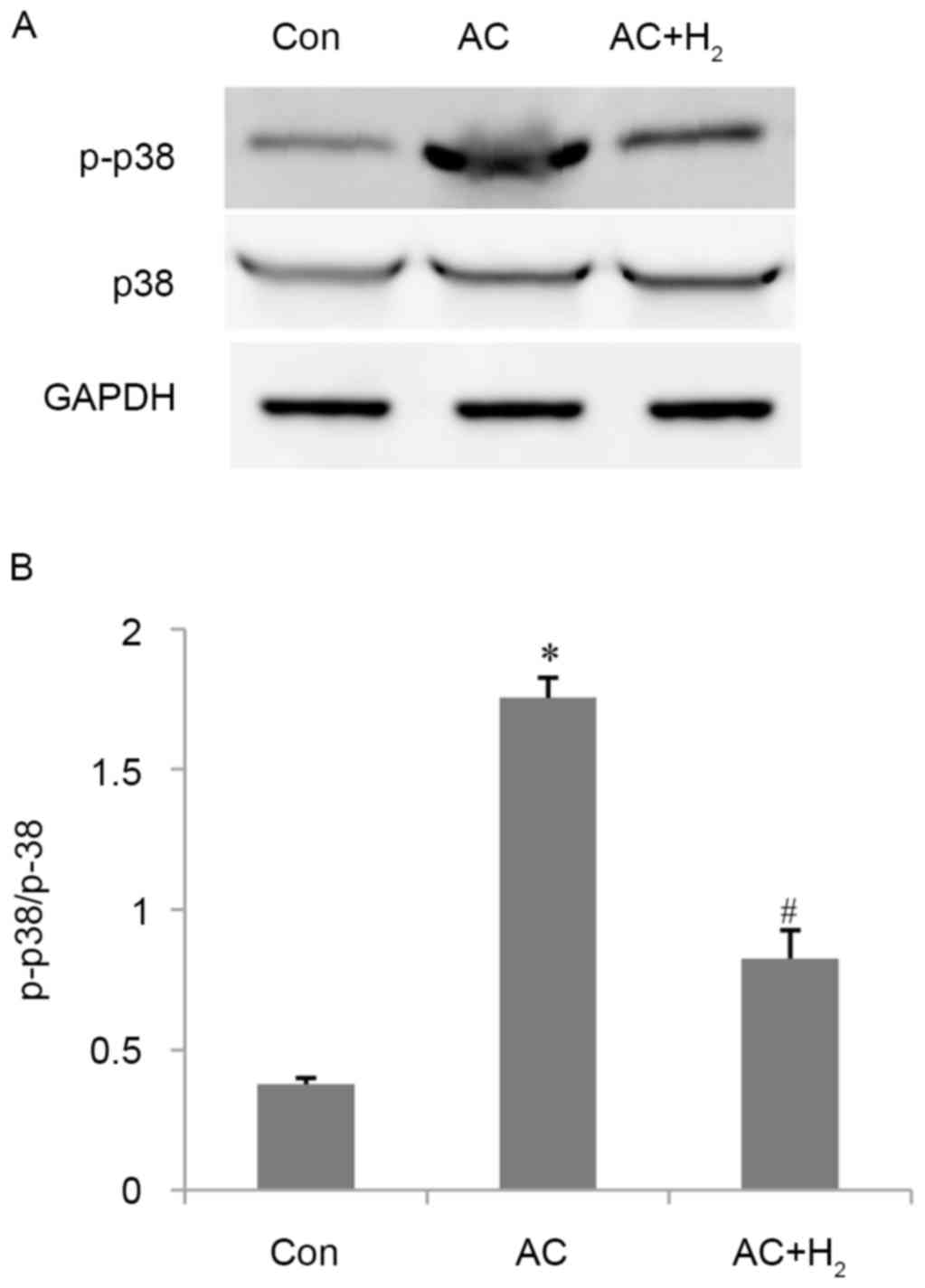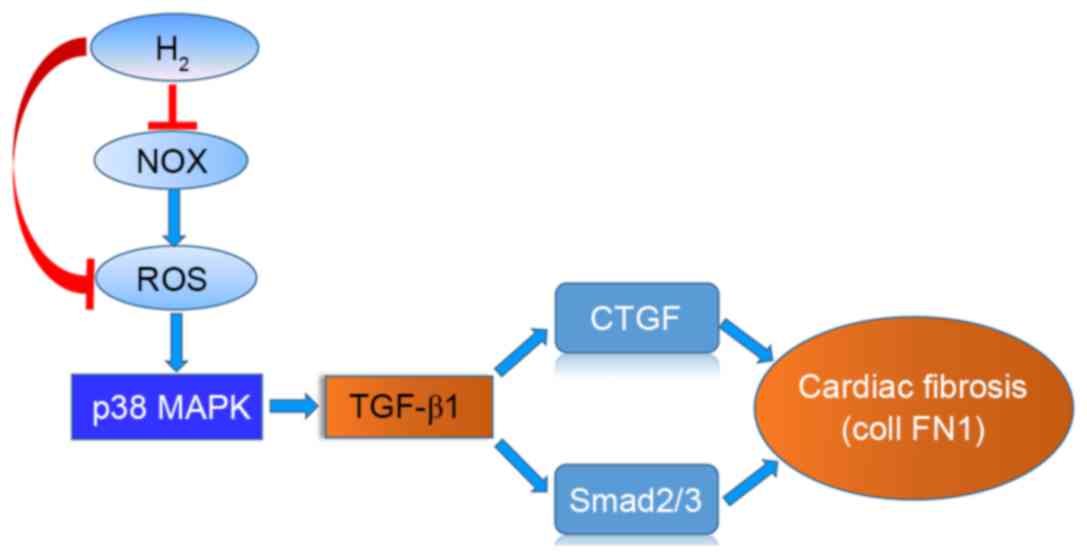Hydrogen-containing saline alleviates pressure overload-induced interstitial fibrosis and cardiac dysfunction in rats
- Authors:
- Published online on: June 23, 2017 https://doi.org/10.3892/mmr.2017.6849
- Pages: 1771-1778
-
Copyright: © Yang et al. This is an open access article distributed under the terms of Creative Commons Attribution License.
Abstract
Introduction
Heart failure is the terminal stage of various cardiovascular diseases and is a global problem with high prevalence (1). Sustained pressure overload associated with hypertension can induce cardiac fibrosis, which is characterized by excess deposition of collagen and other extracellular matrix (ECM) components in the interstitial and peri-vascular regions of the myocardium that lead to myocardial stiffness and ultimately, to heart failure (2). Therapeutic strategies that reduce cardiac fibrosis may therefore block the progression of cardiac fibrosis to heart failure in hypertensive heart diseases.
Transforming growth factor (TGF)-β1 serves an essential role in cardiac fibrosis by inducing the proliferation of cardiac fibroblasts and stimulating ECM deposition (3). It has been reported that TGF-β1 antagonists can prevent myocardial fibrosis and heart failure (4). Smad2/3 is the important downstream signaling of TGF-β1, and connective tissue growth factor (CTGF) also serves as a critical downstream target gene of TGF-β1 to prompt fibrosis (5). The generation of reactive oxygen species (ROS) by nicotinamide adenine dinucleotide phosphate oxidases (NOX) is increased under pressure overload, and induces other enzymes such as xanthine oxidase and nitric oxide synthase to enhance ROS formation (6). NOX2 and NOX4 are notably relevant to cardiac pathophysiology. Excessive ROS levels can directly affect matrix protein expression and metabolism (2) in addition to cytokine and growth factor signaling in cardiac fibrosis. For example, the upregulation of TGF-β1 by angiotensin (Ang) II is mediated by NOX-induced ROS, which activates downstream ROS-sensitive kinases such as p38 mitogen-activated protein kinase (MAPK) in cardiomyocytes and fibroblasts (7). In addition, enalaprilat, an AngII-converting enzyme inhibitor, suppresses cardiac fibroblast proliferation induced by Ang II by blocking NOX/ROS/p38 MAPK/TGF-β1 signaling (8).
Hydrogen (H2) has been proposed as a medical gas in prophylactic and therapeutic applications with a diverse physiological profile. Due to the fact that H2 was demonstrated to mitigate ischemia/reperfusion (I/R) injury in the brain owing to its anti-oxidative properties (9), a number of studies have reported its biological effects against oxidative stress and other aspects, including anti-inflammatory (10), anti-apoptotic (11), anti-allergenic (12) and metabolism-stimulating effects (13). In the cardiovascular system, H2 treatment protects against myocardial I/R injury (14,15), the development of atherosclerosis (16) and radiation-induced cellular damage (17) while enhancing cardiac graft transplantation (18) and reducing left ventricular (LV) hypertrophy (19). However, the benefits of H2 for pressure overload-induced cardiac fibrosis remain unclear. The present study investigated the effects and underlying mechanisms of hydrogen-containing saline (HCS) treatment in a rat model of interstitial fibrosis and cardiac dysfunction induced by abdominal aortic constriction (AC).
Materials and methods
Animals and ethics
A total of 60 adult (6-week-old) male Wistar rats (150–200 g) from the Laboratory Animal Center of the First Affiliated Hospital of Harbin Medical University (Harbin, China) were maintained in a temperature- and humidity-controlled room with free access to food and water for 1 week prior to the operation. Experimental procedures were in compliance with the Guide for the Care and Use of Laboratory Animals of the National Research Council of China (20) and were approved by the Ethics Committee of the First Affiliated Hospital of Harbin Medical University.
HCS preparation
HCS was produced by introducing H2 gas (flow rate: 1 l/min) into 500 ml of 0.9% saline solution with stirring for 10 min until reaching the point of saturation (21). HCS was freshly prepared every week and stored at 4°C under atmospheric pressure in an aluminum bag with no dead volume. Hydrogen content in the saline and in animal blood was confirmed by gas chromatography as previously described (9).
Abdominal AC and HCS administration
Rats were subjected to suprarenal abdominal AC as previously described (22). Briefly, rats were anaesthetized by intraperitoneal injection of 10% chloral hydrate (3 ml/kg), and a 4–0 suture was tied around the suprarenal aorta with a 21-gauge needle placed alongside to yield an internal diameter of 0.8 mm. A total of three days later, surviving AC rats were randomly assigned to the AC + saline (AC; n=7) and AC + HCS treatment (AC + H2; n=7) groups for 16 weeks, during which time 10 ml/kg of HCS or saline was administered every morning to the animals via intraperitoneal injection. Randomly selected normal rats served as the control group (Con; n=8), and were administrated with the same dose of saline.
Echocardiography
Transthoracic echocardiography was performed prior and subsequent to HCS administration with an ultrasound apparatus (SONOS 7500; Philips, Rotterdam, The Netherlands) equipped with a 12-MHz transducer. LV end-diastolic diameter (LVDd), LV end-systolic diameter (LVSd), interventricular septum thickness (IVSd) and LV posterior wall thickness (LVPWd) were measured. LV ejection fraction (EF) and fractional shortening (FS) were calculated from M-mode recordings. Measurements from three consecutive cardiac cycles were averaged and data were analyzed by a blinded observer.
Morphometric and histopathological analysis
Following echocardiographic measurements and blood sample collection, the heart was dissected and weighed. The LV was separated from the atria, right ventricle and the large vessels then was weighed, immersion-fixed in 4% buffered paraformaldehyde and flash frozen in liquid nitrogen until use. Heart weight (HW) and LV weight (LVW) were used to calculate the HW/body weight (BW) and LVW/BW ratios. Paraffin-embedded tissue was cut into 4 µm serial sections that were stained with Masson's trichrome to evaluate ECM deposition. Digital images of 10 fields were randomly selected from each section of the LV by a light microscope (Olympus Corporation, Tokyo, Japan) and the percent of fibrosis area was analyzed with Image-Pro Plus 6.0 image analysis software (Media Cybernetics, Inc., Rockville, MD, USA).
Measurement of ROS
Intracellular ROS production in the LV tissues was detected by the use of 2,7-dichlorofluorescin diacetate (CM-H2DCFDA) (Shanghai Genmed, Gene Pharmaceutical Technology Co., Ltd., Shanghai, China) fluorescent dye. Briefly, frozen heart tissues were incubated with 500 µl CM-H2DCFDA and dissolved in Reagent C (500:1, Shanghai Genmed, Gene Pharmaceutical Technology Co., Ltd.) at 37°C for 20 min. Fluorescence was detected by confocal laser scanning microscopy with red light and measuring the intensity of red fluorescence, where the ROS content increased in proportion to the intensity of red fluorescence.
Measurement of malondialdehyde (MDA) concentration and superoxide dismutase (SOD) activity and hydroxyproline content
MDA is a marker of oxidant-mediated lipid peroxidation, whereas SOD is an antioxidant enzyme. Hydroxyproline, the decomposition product of collagen, is considered to be an index of collagen quantity. MDA concentration, SOD activity and hydroxyproline content were measured in LV tissue homogenates using commercial kits (Nanjing Jiancheng Bioengineering Research Institute, Nanjing, China) according to the manufacturer's protocols. For the MDA and SOD assay, frozen tissues were homogenized in a saline buffer and centrifuged at 1,082 × g for 10 min at room temperature to obtain supernatant, and then were determined its protein concentration. For detecting hydroxyproline, frozen tissues were weighed, hydrolyzed with alkali and centrifuged at 2,121 × g for 10 min at room temperature to obtain the supernatant. MDA concentration, SOD activity and hydroxyproline content were measured by spectrophotometer colorimetry (722G; Shanghai Jingke Scientific Instrument Co., Ltd., Shanghai, China) at 532, 450 and 550 nm, respectively. The final results of MDA concentration and SOD activity were corrected for protein content, and hydroxyproline content was expressed as µg/g wet weight.
Western blot analysis
Frozen LV tissue was mechanically lysed using RIPA buffer (Beyotime Institute of Biotechnology, Shanghai, China), then centrifuged at 12,000 × g and 4°C for 10 min. Protein concentration was estimated with the Bicinchoninic Acid Protein Assay kit (Beyotime Insitute of Biotechnology). Protein samples (60 µg per lane) were separated by sodium dodecyl sulfate-polyacrylamide gel electrophoresis and transferred to a polyvinylidene difluoride membrane (EMD Millipore, Billerica, MA, USA), which was blocked with 5% skimmed milk for 2 h at room temperature and then probed overnight at 4°C with rabbit polyclonal antibodies against TGF-β1 (1:1,000; GTX110630; GeneTex, Irvine, CA, USA) and NOX4 (1:500, sc-30141, Santa Cruz Biotechnology, Inc., Dallas, TX, USA), rabbit monoclonal antibodies against NOX2 (1:1,000; ab129068; Abcam, Cambridge, MA, USA), phosphorylated-Smad2/3 (p-Smad2/3; 1:1,000; no. 8828; Cell Signaling Technology, Inc., Danvers, MA, USA), Smad2/3 (1:1,000; no. 8685; Cell Signaling Technology, Inc.), p38 MAPK (D13E1) (1:1,000; no. 8690; Cell Signaling Technology, Inc.), p-p38 MAPK (Thr180/Tyr182) (D3F9) (1:1,000; no. 4511; Cell Signaling Technology, Inc.) and mouse monoclonal antibodies against CTGF (E-5) (1:50; sc-365970; Santa Cruz Biotechnology, Inc.) and glyceraldehyde 3-phosphate dehydrogenase (GAPDH; 1:5,000; KC-5G4; KangChen Bio-tech, Inc., Shanghai, China). The membrane was washed three times for 10 min with phosphate-buffered saline containing 0.5% Tween-20, then incubated for 2 h with the secondary goat antibodies against rabbit (ZDR-5306) or mouse (ZDR-5307) IgG conjugated to horseradish peroxidase (1:2,000; OriGene Technologies, Beijing, China). Protein bands were visualized by enhanced chemiluminescence using western blot detection reagents (Thermo Fisher Scientific, Inc., Waltham, MA, USA) and exposed to X-ray film, which was digitized with a scanner (LiED 110; Canon, Inc., Tokyo, Japan). The band intensity (area × optical density) in each group was measured using ImageJ 1.45s software (National Institutes of Health, Bethesda, MD, USA) and normalized to that of GAPDH.
Reverse transcription-quantitative polymerase chain reaction (RT-qPCR)
Total RNA was extracted from LV tissue samples using RNAiso Plus (Takara Bio, Inc., Otsu, Japan) and 1 µg was reverse transcribed into cDNA, using the PrimeScript RT Reagent kit with gDNA Eraser (Takara Bio, Inc.) and M-MLV Reverse Transcriptase (Takara Biotechnology Co., Ltd., Dalian, China), according to the manufacturer's protocol. RT-qPCR analysis was conducted with SYBR-Green (Roche Diagnostics GmbH, Mannheim, Germany) on an ABI 7500 RT-PCR system (Applied Biosystems; Thermo Fisher Scientific, Inc.) in order to determine the mRNA levels of collagen I (Col I), fibronectin 1 (FN1) and GAPDH. The primer sequences were as follows: Col I, 5′-GACTGGCAACCTCAAGAAGG-3′ (forward) and 5′-GACTGTCTTGCCCCAAGTTC-3′ (reverse); FN1, 5′-TACACGGTTTCCCATTACGC-3′ (forward) and 5′-CCTTTCCATTCCCGAGACAT-3′ (reverse); GAPDH, 5′-GGAAAGCTGTGGCGTGAT-3′ (forward) and 5′-AAGGTGGAAGAATGGGAGTT-3′ (reverse). Among them, GAPDH was used as an internal standard. The qPCR reaction mixture consisted of 10 µl SYBR-Green, 0.2 µl forward primer, 0.2 µl reverse primer, 2 µl cDNA and 7.6 µl sterile water. Following the thermal treatment of 15 min at 95°C, the reactions were conducted using 45 cycles of 15 sec at 95°C, 30 sec at 55°C, 30 sec at 72°C, followed by a final extension for 7 min at 72°C. The expression of target genes was quantified relative to the level of GAPDH using the ΔΔCq method (23).
Statistical analysis
Data are expressed as the mean ± standard deviation. One-way analysis of variance followed by Tukey's post hoc test was conducted to determine differences among groups using SPSS software, version 20.0 (IBM Corp., Armonk, NY, USA). P<0.05 was considered to indicate a statistically significant difference.
Results
H2 treatment improves cardiac function induced by pressure overload
The effect of H2 on cardiac function was assessed by echocardiography (Table I). Chronic pressure overload resulted in a decline in EF and FS in the AC as compared with the Con group (all P<0.001), indicating impaired cardiac function. Treatment with HCS improved both parameters as compared with the AC group (all P<0.001). Chronic pressure overload also caused the dilation of the heart, as evidenced by increases in LVDd and LVSd in the AC relative to the Con group (all P<0.001). HCS treatment attenuated the increase in LV dimension (all P<0.001). However, there were no differences in IVSd and LVPWd across groups (all P>0.05).
In addition, the morphometric parameters of the heart were also examined (Table I). BW was similar across groups. LVW, LVW/BW and HW/BW were increased in the AC as compared with the Con group (all P<0.01). However, HCS treatment didn't suppress the increase in LVW, LVW/BW and HW/BW as compared with the AC group (all P>0.05). These results indicate that HCS treatment improved cardiac function however had no effects on cardiac hypertrophy induced by sustained pressure overload.
H2 treatment reduces interstitial fibrosis induced by pressure overload
ECM deposition was assessed by Masson's trichrome staining (Fig. 1A and B). The interstitial fibrotic area was greater in the AC as compared with the Con group (P<0.001). Treatment with HCS reduced ECM deposition (AC + H2 vs. AC; P<0.001). Consistent with the above results, the LV hydroxyproline content (Fig. 1C) was increased in the AC as compared with the Con group (P<0.001), whereas the content was decreased in HCS-treated rats (AC + H2 vs. AC; P<0.01). In the AC group, the mRNA levels of Col I and FN1, two ECM components, were upregulated by approximately 2-fold and 6-fold, respectively, as compared with control rats (all P<0.001; Fig. 1D and E); HCS treatment inhibited the expression of both transcripts to 68% for Col I and 65% for FN1 of the levels in the AC group (all P<0.01).
H2 abolishes the increase in TGF-β1 and its downstream genes induced by pressure overload
TGF-β1 serves a key role in the development of cardiac fibrosis. AC resulted in an increase in TGF-β1 protein level compared with control rats (P<0.001; Fig. 2A and B). HCS treatment abolished the AC-induced upregulation of TGF-β1 (P<0.001). The phosphorylation of Smad2/3 and CTGF protein level were upregulated following the tendency of TGF-β1 in AC group when compared with the Con group (all P<0.01; Fig. 2A, C and D), however significantly decreased in the AC + H2 group (AC + H2 vs. AC; P<0.05). These results indicate that hydrogen inhibits TGF-β1 and its downstream signaling.
H2 reduced ROS formation in the myocardium
ROS production in the LV tissues was detected by CM-H2DCFDA fluorescence (Fig. 3). The ROS content, indicating a higher concentration of red fluorescent particles, was significantly increased in the AC group, compared with the Con group. However, HCS treatment decreased the ROS level of the AC group.
H2 restores MDA levels and SOD activity in the myocardium
MDA levels and SOD activity are reliable indicators of oxidative stress and antioxidant capacity, respectively. AC resulted in a 65% increase in MDA content and a 43% decrease in SOD activity (all P<0.01) compared with the Con group (Fig. 4). HCS treatment abrogated these effects, reducing MDA levels and increasing SOD activity (all P<0.05) as compared with the AC group. These results indicate that hydrogen an antioxidant effect on the pressure-overloaded heart.
H2 inhibits NOX2 and NOX4 expression induced by pressure overload
The protein levels of NOX2 and NOX4 were illustrated in Fig. 5. Their expression of NOX2 and NOX4 were increased in the AC compared with the Con group (all P<0.001). Subsequent to treatment with HCS, expression was significantly decreased compared with the AC group (all P<0.001). These results indicate that HCS treatment could attenuate oxidative stress by partially inhibiting the expression of NOX2 and NOX4.
H2 inhibits p38 MAPK activation induced by pressure overload
AC increased the percentage of phosphorylation of p38 MAPK by 3.6-fold as compared with control animals (P<0.001) (Fig. 6). HCS treatment decreased the ratio of p-p38 MAPK/p38 MAPK by 53% compared with the AC group (P<0.001).
Discussion
H2 has been widely used in clinical applications owing to its capacity to specifically neutralize cytotoxic oxygen radicals (24). Previously studies have demonstrated that H2 administration has protective effects against cerebral reperfusion injury, neurodegeneration and metabolic syndromes for patients by inhalation of H2 gas, intake of H2-dissolved water, or injection of H2-dissolved saline (25), among which injection of H2-dissolved saline ensures more accurate delivery of H2 (24). H2 has a protective effect on the cardiovascular system (14,18,19,26–28); however, the role of H2 in pressure overload-induced cardiac fibrosis has not, to the best of our knowledge, been previously investigated. The present study demonstrated that HCS treatment prevents interstitial fibrosis and the progression of heart failure induced by pressure overload in rats. These effects were accompanied by changes in the levels of oxidative stress markers and the expression of pro-fibrotic factors. The results indicate that HCS may be effective for treating cardiac fibrosis and heart failure caused by hypertension-induced pressure overload.
Hypertension affects approximately 1 billion people worldwide and is a major public health challenge (29). Pressure overload induces early cardiac hypertrophy, fibrosis and diastolic dysfunction; when these persist, the heart becomes decompensated and dilated, eventually leading to systolic dysfunction (2). A previous study identified that fibrosis can promote the transition from left ventricular hypertrophy to heart failure (30). As such, reversing or preventing cardiac fibrosis is an important goal for improving the prognosis of patients with hypertensive heart disease. In the present study, cardiac fibrosis, LV dilation and systolic dysfunction were observed in rats in which pressure overload was induced by AC after 16 weeks. However, HCS treatment shortened LVDd and LVSd, reduced interstitial fibrotic area, and increased EF and FS, but did not decrease IVSd, LVPWd, LVW/BW or HW/BW ratios. The results indicated that initial cardiac hypertrophy progressed to cardiac fibrosis and heart failure (22), which were mitigated by H2. A previous study reported that HCS treatment attenuates left ventricular hypertrophy in spontaneously hypertensive rats, which differed from the results of the present study, potentially due to the fact that different time points were examined (19).
Oxidative stress serves a critical role in heart failure resulting from sustained pressure overload (31). The expression of oxidative stress markers is upregulated in the advent of heart failure (32), in addition to during the transition from hypertrophy to heart failure (33). It was demonstrated that the levels of ROS and MDA, an index of lipid peroxidation, were increased by AC, an effect that was reversed by HCS treatment. It was previously observed that HCS treatment protected against doxorubicin-induced heart failure, which was accompanied by a downregulation of MDA levels (34). In addition, antioxidant capacity, as reflected by SOD, was impaired under pressure overload, and this was also ameliorated by HCS treatment.
ROS levels are increased in various types of heart diseases, including cardiac hypertrophy, fibrosis and heart failure (35,36). ROS have been reported to activate TGF-β1 to enhance ECM deposition in the interstitium (37). TGF-β1 is an important fibrogenic factor that mediates the proliferation of fibroblast and conversion to myofibroblasts in addition to the production of ECM components including fibrillar collagen and fibronectin (2). CTGF is induced by TGF-β1 through signaling cascades such as Smad2/3, and is essential for TGF-β1-induced collagen synthesis (5). In the present study, Col I and FN1 mRNA levels and hydroxyproline content were upregulated under pressure overload. CTGF protein expression and the ratio of p-Smad2/3 to Smad2/3 were additionally upregulated following TGF-β1. Administration of HCS abolished these effects and reduced ECM deposition. These results are consistent with that of a previous study demonstrating that TGF-β1 expression was induced by pressure overload, and that blocking its activity prevented myocardial fibrosis and cardiac dysfunction (38).
NOX are the main sources of ROS in the cardiovascular system, and among them, NOX2 and NOX4 serve an important role in the development of cardiac hypertrophy and interstitial fibrosis. p38 MAPK serves a key role in intracellular signal transduction in cardiac development and pathology (39). For example, p38 MAPK mediates the upregulation of TGF-β1 induced by AngII, which is also dependent on NOX-induced ROS (7). In addition, ROS/p38 MAPK/TGF-β1 signaling is essential for cardiac fibroblast proliferation (8). It was observed that pressure overload increased oxidative stress, p38 MAPK phosphorylation and TGF-β1 expression; these were abrogated by HCS treatment, suggesting that H2 can inhibit ROS/p38 MAPK/TGF-β1 signaling to improve interstitial fibrosis. However, intracellular ROS production should be directly measured and the effect of inhibiting NOX activity on TGF-β1 expression must be analyzed in a further study.
H2 has been previously reported to suppress the production of cytotoxic oxygen radicals, including •OH and ONOO− (9); it also regulates gene expression and the phosphorylation of signaling proteins. H2 was demonstrated to inhibit the expression of matrix metalloproteinase (MMP)-2 and −9 (40) in addition to the phosphorylation of p38MAPK, exerting anti-allergenic and anti-inflammatory effects (12,41). However, the primary molecular target of H2 remains unclear, and further studies are required to clarify the mechanism by which H2 regulates TGF-β1 expression and to determine whether it directly attenuates cardiac fibrosis by negatively regulating MMP2 and −9 levels.
In conclusion, HCS treatment reduced interstitial fibrosis and improved cardiac function in pressure-overloaded rats, which was likely mediated by its anti-oxidative properties and via inhibition of p38 MAPK phosphorylation and TGF-β1 downstream signaling. A schematic of the action of H2 is presented in Fig. 7. These data may provide a potential therapeutic application of H2 in preventing cardiac fibrosis and the progression of heart failure.
Acknowledgements
The authors would like to thank International Science Editing for the English language editing of the manuscript.
References
|
Braunwald E: The war against heart failure: The Lancet lecture. Lancet. 385:812–824. 2015. View Article : Google Scholar : PubMed/NCBI | |
|
Kong P, Christia P and Frangogiannis NG: The pathogenesis of cardiac fibrosis. Cell Mol Life Sci. 71:549–574. 2014. View Article : Google Scholar : PubMed/NCBI | |
|
Dobaczewski M, Chen W and Frangogiannis NG: Transforming growth factor (TGF)-β signaling in cardiac remodeling. J Mol Cell Cardiol. 51:600–606. 2011. View Article : Google Scholar : PubMed/NCBI | |
|
Lim H and Zhu YZ: Role of transforming growth factor-beta in the progression of heart failure. Cell Mol Life Sci. 63:2584–2596. 2006. View Article : Google Scholar : PubMed/NCBI | |
|
Creemers EE and Pinto YM: Molecular mechanisms that control interstitial fibrosis in the pressure-overloaded heart. Cardiovasc Res. 89:265–272. 2011. View Article : Google Scholar : PubMed/NCBI | |
|
Murdoch CE, Zhang M, Cave AC and Shah AM: NADPH oxidase-dependent redox signalling in cardiac hypertrophy, remodelling and failure. Cardiovasc Res. 71:208–215. 2006. View Article : Google Scholar : PubMed/NCBI | |
|
Rosenkranz S: TGF-beta1 and angiotensin networking in cardiac remodeling. Cardiovasc Res. 63:423–432. 2004. View Article : Google Scholar : PubMed/NCBI | |
|
Yu M, Zheng Y, Sun HX and Yu DJ: Inhibitory effects of enalaprilat on rat cardiac fibroblast proliferation via ROS/P38MAPK/TGF-β1 signaling pathway. Molecules. 17:2738–2751. 2012. View Article : Google Scholar : PubMed/NCBI | |
|
Ohsawa I, Ishikawa M, Takahashi K, Watanabe M, Nishimaki K, Yamagata K, Katsura K, Katayama Y, Asoh S and Ohta S: Hydrogen acts as a therapeutic antioxidant by selectively reducing cytotoxic oxygen radicals. Nat Med. 13:688–694. 2007. View Article : Google Scholar : PubMed/NCBI | |
|
Xie K, Yu Y, Pei Y, Hou L, Chen S, Xiong L and Wang G: Protective effects of hydrogen gas on murine polymicrobial sepsis via reducing oxidative stress and HMGB1 release. Shock. 34:90–97. 2010. View Article : Google Scholar : PubMed/NCBI | |
|
Cai J, Kang Z, Liu WW, Luo X, Qiang S, Zhang JH, Ohta S, Sun X, Xu W, Tao H and Li R: Hydrogen therapy reduces apoptosis in neonatal hypoxia-ischemia rat model. Neurosci Lett. 441:167–172. 2008. View Article : Google Scholar : PubMed/NCBI | |
|
Itoh T, Fujita Y and Ito M, Masuda A, Ohno K, Ichihara M, Kojima T, Nozawa Y and Ito M: Molecular hydrogen suppresses FcepsilonRI-mediated signal transduction and prevents degranulation of mast cells. Biochem Biophys Res Commun. 389:651–656. 2009. View Article : Google Scholar : PubMed/NCBI | |
|
Kamimura N, Nishimaki K, Ohsawa I and Ohta S: Molecular hydrogen improves obesity and diabetes by inducing hepatic FGF21 and stimulating energy metabolism in db/db mice. Obesity (Silver Spring). 19:1396–1403. 2011. View Article : Google Scholar : PubMed/NCBI | |
|
Yoshida A, Asanuma H, Sasaki H, Sanada S, Yamazaki S, Asano Y, Shinozaki Y, Mori H, Shimouchi A, Sano M, et al: H(2) mediates cardioprotection via involvements of K(ATP) channels and permeability transition pores of mitochondria in dogs. Cardiovasc Drugs Ther. 26:217–226. 2012. View Article : Google Scholar : PubMed/NCBI | |
|
Sun Q, Kang Z, Cai J, Liu W, Liu Y, Zhang JH, Denoble PJ, Tao H and Sun X: Hydrogen-rich saline protects myocardium against ischemia/reperfusion injury in rats. Exp Biol Med (Maywood). 234:1212–1219. 2009. View Article : Google Scholar : PubMed/NCBI | |
|
Ohsawa I, Nishimaki K, Yamagata K, Ishikawa M and Ohta S: Consumption of hydrogen water prevents atherosclerosis in apolipoprotein E knockout mice. Biochem Biophys Res Commun. 377:1195–1198. 2008. View Article : Google Scholar : PubMed/NCBI | |
|
Qian L, Cao F, Cui J, Wang Y, Huang Y, Chuai Y, Zaho L, Jiang H and Cai J: The potential cardioprotective effects of hydrogen in irradiated mice. J Radiat Res. 51:741–747. 2010. View Article : Google Scholar : PubMed/NCBI | |
|
Noda K, Shigemura N, Tanaka Y, Kawamura T, Lim S Hyun, Kokubo K, Billiar TR, Bermudez CA, Kobayashi H and Nakao A: A novel method of preserving cardiac grafts using a hydrogen-rich water bath. J Hear Lung Transplant. 32:241–250. 2013. View Article : Google Scholar | |
|
Yu YS and Zheng H: Chronic hydrogen-rich saline treatment reduces oxidative stress and attenuates left ventricular hypertrophy in spontaneous hypertensive rats. Mol Cell Biochem. 365:233–242. 2012. View Article : Google Scholar : PubMed/NCBI | |
|
Regulations of People's Republic of China for Administration of Laboratory Animals. State Science and Technology Commission; Beijing: 1988 | |
|
Oharazawa H, Igarashi T, Yokota T, Fujii H, Suzuki H, Machide M, Takahashi H, Ohta S and Ohsawa I: Protection of the retina by rapid diffusion of hydrogen: Administration of hydrogen-loaded eye drops in retinal ischemia-reperfusion injury. Investig Ophthalmol Vis Sci. 51:487–492. 2010. View Article : Google Scholar | |
|
Ma Y, Chen Y, Yang Y, Chen B, Liu D, Xiong Z, Zhang C and Dong Y: Proteasome inhibition attenuates heart failure during the late stages of pressure overload through alterations in collagen expression. Biochem Pharmacol. 85:223–233. 2013. View Article : Google Scholar : PubMed/NCBI | |
|
Livak KJ and Schmittgen TD: Analysis of relative gene expression data using real-time quantitative PCR and the 2(−Delta Delta C(T)) method. Methods. 25:402–408. 2001. View Article : Google Scholar : PubMed/NCBI | |
|
Ohta S: Recent progress toward hydrogen medicine: Potential of molecular hydrogen for preventive and therapeutic applications. Curr Pharm Des. 17:2241–2252. 2011. View Article : Google Scholar : PubMed/NCBI | |
|
Ohta S: Molecular hydrogen as a preventive and therapeutic medical gas: Initiation, development and potential of hydrogen medicine. Pharmacol Ther. 144:1–11. 2014. View Article : Google Scholar : PubMed/NCBI | |
|
Hayashida K, Sano M, Ohsawa I, Shinmura K, Tamaki K, Kimura K, Endo J, Katayama T, Kawamura A, Kohsaka S, et al: Inhalation of hydrogen gas reduces infarct size in the rat model of myocardial ischemia-reperfusion injury. Biochem Biophys Res Commun. 373:30–35. 2008. View Article : Google Scholar : PubMed/NCBI | |
|
Hayashida K, Sano M, Kamimura N, Yokota T, Suzuki M, Maekawa Y, Kawamura A, Abe T, Ohta S, Fukuda K and Hori S: H(2) gas improves functional outcome after cardiac arrest to an extent comparable to therapeutic hypothermia in a rat model. J Am Heart Assoc. 1:e0034592012. View Article : Google Scholar : PubMed/NCBI | |
|
Hayashi T, Yoshioka T, Hasegawa K, Miyamura M, Mori T, Ukimura A, Matsumura Y and Ishizaka N: Inhalation of hydrogen gas attenuates left ventricular remodeling induced by intermittent hypoxia in mice. Am J Physiol Heart Circ Physiol. 301:H1062–H1069. 2011. View Article : Google Scholar : PubMed/NCBI | |
|
Kearney PM, Whelton M, Reynolds K, Muntner P, Whelton PK and He J: Global burden of hypertension: Analysis of worldwide data. Lancet. 365:217–223. 2005. View Article : Google Scholar : PubMed/NCBI | |
|
Lazzeroni D, Rimoldi O and Camici PG: From left ventricular hypertrophy to dysfunction and failure. Circ J. 80:555–564. 2016. View Article : Google Scholar : PubMed/NCBI | |
|
Sawyer DB, Siwik DA, Xiao L, Pimentel DR, Singh K and Colucci WS: Role of oxidative stress in myocardial hypertrophy and failure. J Mol Cell Cardiol. 34:379–388. 2002. View Article : Google Scholar : PubMed/NCBI | |
|
Van Kimmenade RR and Januzzi JL Jr: Emerging biomarkers in heart failure. Clin Chem. 58:127–138. 2012. View Article : Google Scholar : PubMed/NCBI | |
|
Dhalla AK, Hill MF and Singal PK: Role of oxidative stress in transition of hypertrophy to heart failure. J Am Coll Cardiol. 28:506–514. 1996. View Article : Google Scholar : PubMed/NCBI | |
|
Wu S, Zhu L, Yang J, Fan Z, Dong Y, Luan R, Cai J and Fu L: Hydrogen-containing saline attenuates doxorubicin-induced heart failure in rats. Pharmazie. 69:633–636. 2014.PubMed/NCBI | |
|
Takimoto E and Kass DA: Role of oxidative stress in cardiac hypertrophy and remodeling. Hypertension. 49:241–248. 2007. View Article : Google Scholar : PubMed/NCBI | |
|
Tsutsui H, Kinugawa S and Matsushima S: Oxidative stress and heart failure. Am J Physiol Heart Circ Physiol. 301:H2181–H2190. 2011. View Article : Google Scholar : PubMed/NCBI | |
|
Barcellos-Hoff MH and Dix TA: Redox-mediated activation of latent transforming growth factor-beta 1. Mol Endocrinol. 10:1077–1083. 1996. View Article : Google Scholar : PubMed/NCBI | |
|
Kuwahara F, Kai H, Tokuda K, Kai M, Takeshita A, Egashira K and Imaizumi T: Transforming growth factor-beta function blocking prevents myocardial fibrosis and diastolic dysfunction in pressure-overloaded rats. Circulation. 106:130–135. 2002. View Article : Google Scholar : PubMed/NCBI | |
|
Wang Y: Mitogen-activated protein kinases in heart development and diseases. Circulation. 116:1413–1423. 2007. View Article : Google Scholar : PubMed/NCBI | |
|
Chen CH, Manaenko A, Zhan Y, Liu WW, Ostrowki RP, Tang J and Zhang JH: Hydrogen gas reduced acute hyperglycemia-enhanced hemorrhagic transformation in a focal ischemia rat model. Neuroscience. 169:402–414. 2010. View Article : Google Scholar : PubMed/NCBI | |
|
Cardinal JS, Zhan J, Wang Y, Sugimoto R, Tsung A, McCurry KR, Billiar TR and Nakao A: Oral hydrogen water prevents chronic allograft nephropathy in rats. Kidney Int. 77:101–109. 2010. View Article : Google Scholar : PubMed/NCBI |



